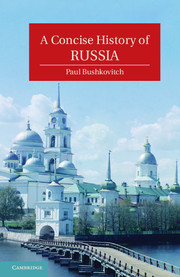Book contents
- Frontmatter
- Contents
- List of Figures
- Abbreviations
- Acknowledgments
- Prologue
- 1 Russia before Russia
- 2 Moscow, Novgorod, Lithuania, and the Mongols
- 3 The Emergence of Russia
- 4 Consolidation and Revolt
- 5 Peter the Great
- 6 Two Empresses
- 7 Catherine the Great
- 8 Russia in the Age of Revolution
- 9 The Pinnacle of Autocracy
- 10 Culture and Autocracy
- 11 The Era of the Great Reforms
- 12 From Serfdom to Nascent Capitalism
- 13 The Golden Age of Russian Culture
- 14 Russia as an Empire
- 15 Autocracy in Decline
- 16 War and Revolution
- 17 Compromise and Preparation
- 18 Revolutions in Russian Culture
- 19 Building Utopia
- 20 War
- 21 Growth, Consolidation, and Stagnation
- 22 Soviet Culture
- 23 The Cold War
- Epilogue
- Further Reading
- Index
18 - Revolutions in Russian Culture
Published online by Cambridge University Press: 05 June 2012
- Frontmatter
- Contents
- List of Figures
- Abbreviations
- Acknowledgments
- Prologue
- 1 Russia before Russia
- 2 Moscow, Novgorod, Lithuania, and the Mongols
- 3 The Emergence of Russia
- 4 Consolidation and Revolt
- 5 Peter the Great
- 6 Two Empresses
- 7 Catherine the Great
- 8 Russia in the Age of Revolution
- 9 The Pinnacle of Autocracy
- 10 Culture and Autocracy
- 11 The Era of the Great Reforms
- 12 From Serfdom to Nascent Capitalism
- 13 The Golden Age of Russian Culture
- 14 Russia as an Empire
- 15 Autocracy in Decline
- 16 War and Revolution
- 17 Compromise and Preparation
- 18 Revolutions in Russian Culture
- 19 Building Utopia
- 20 War
- 21 Growth, Consolidation, and Stagnation
- 22 Soviet Culture
- 23 The Cold War
- Epilogue
- Further Reading
- Index
Summary
Unlike Russia's state and society, its culture did not experience such a sharp break in 1917. The period from about 1890 to the middle of the 1920s was full of artistic revolutions, happening simultaneously and in entirely different directions. These revolutions shared many characteristics with artistic movements in the rest of the world, but paradoxically the Russian culture of the Silver Age, as it is known (by comparison to the Golden Age in the nineteenth century) has never acquired an audience outside of Russia comparable to that which the writers and musicians of the earlier period secured. Perhaps one of the main reasons is that most of the truly talented writers of the Silver Age were poets, masters of that most untranslatable of art forms. The natural scientists, in contrast, began to acquire an international audience, in large part because of the efforts of the Soviet regime to encourage and use the sciences to build a new society.
Literature, music, and art
The writers and artists who came to maturity in the 1890s were a mixed lot: symbolists and realists in literature, the “World of Art” group in the visual arts. In about 1910 new waves, or often wavelets, came on to the scene. A whole series of new movements in poetry, futurism, acmeism, and other groups contended for the attention of readers and critics, while the Ballets Russes introduced both new forms of dance and the radical (it seemed) new music of Igor Stravinskii. The speed of innovation only increased. Working in Germany, Wassily Kandinsky produced entirely abstract work by 1911, and in St. Petersburg Kazimir Malevich painted his “Black Square” in 1915. The revolution and civil war split Russian culture in two, with many of the great names of the time staying abroad or emigrating, and others remaining behind with varying degrees of sympathy for the Bolsheviks. The émigrés largely continued their earlier styles, while in Soviet Russia the situation was more complex. Some saw the new order as of the same essence as their artistic revolution, while others espoused even more radical notions and still others tried to combine modernism with socialist content. By the end of the twenties, with the aging of the émigrés and the new Soviet order in art, a new phase began.
- Type
- Chapter
- Information
- A Concise History of Russia , pp. 334 - 350Publisher: Cambridge University PressPrint publication year: 2011



